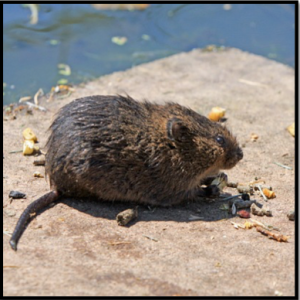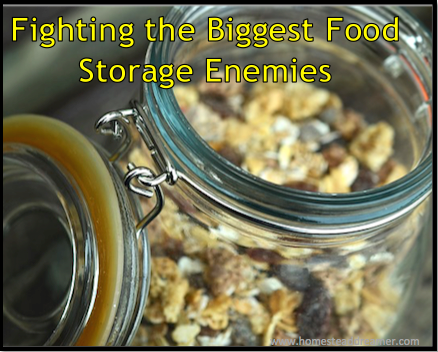Since the beginning of time, humanity has been learning about how to preserve food to last through the winters and hard times. Starting with simple drying or smoking, we worked our way up to freezing, canning, and vacuum sealing. All of these methods have one thing in common: they remove the environment that food storage enemies need to thrive and spoil your food.
Dan Sullivan over at SurvivalSullivan.com graciously offered to help tackle the ways you can store food with considerations to location, temperatures, and staying on top of your emergency food storage.
_____________________
You’d think storing survival food is easy: Just buy your pre-packed bags and buckets, put them in your pantry, and forget about them. Well, things aren’t that simple because food has 5 main enemies and improper storage can quickly spoil it. Believe me, the last thing you want post-collapse is to have all this food only to find you can’t feed it to your spouse and children.
Fighting the food storage enemies is more difficult if you have a stockpile at your bug out retreat. Since you’re not there most of the time, you need to do a good job at protecting your pantry from much more than just thieves. In this article, we’re going to tackle all of them: Heat, Light, Oxygen, Moisture, and Pests.
Heat
The general rule of thumb is the lower the temperature, the longer the food will last. For every 18F (or 10C) increase in temperature, it loses half its shelf life while decreasing the temperature by the same amount will double it. This is a ballpark estimation / generalization but a good baseline.
For example, the last place you want is store your food inside your attic. Even though temperatures may be low during winter, they increase substantially during summer. Instead, use the attic to store your other preps such as clothes, blankets, toilet paper or even bug out vehicles such as mountain bikes. Another problem area comes with the emergency bag stashed inside your car. The temperatures are obviously higher (especially during summer) so you’re going to have to rotate these foods more often.
One of the best places to store your food when it comes to reducing heat is in the basement, particularly longer-term storage. Depending on your climate, the basement could present other challenges (such as moisture) that may need to be dealt with.
Light
It’s not just natural light that spoils food, artificial light causes the same unwanted effect, which also has a name: photo-degradation. The photons are able to destroy a little bit of everything: vitamins, fats, proteins, pigments, you name it.
How to avoid the enemy: as long as you store your survival food in Mylar bags which are then placed in 5 gallon buckets which are then placed in your basement or pantry, you’ve got nothing to worry about. Please keep in mind that some of these buckets are slightly translucent, another good reason to use Mylar bags first.
Oxygen
Loss of flavor, rancidity and bacteria are the three main issues with having oxygen inside your survival food. Some of these the bacteria are lethal… For instance, Clostridium botulinum, the one that causes botulism, needs very little oxygen to grow. This is why you should be using a pressure canner when there is any doubt. More on which food preservation equipment to use can be found right here.
Remember that oxygen doesn’t really need bacteria in order to spoil your food; it can do that on its own by oxidizing lipids. This is why foods with high-fat content have a shorter shelf life.
How to avoid the enemy: getting the canning process right; using Mylar bags, oxygen absorbers and airtight (gamma seal lids help!) 5-gallon plastic buckets for some of the other foods such as dried beans, rice, pasta and even vitamins!
Moisture
This enemy should be of particular interest to you if you live in a high humidity area. Water and moisture can affect your food in two ways: They allow microorganisms to thrive inside it and allow certain chemical reactions that can permanently damage it.
You can control water by drying, dehydrating, freezing your foods, or using additives such as salt and sugar… but that’s not enough. You also need to keep moisture out of the containers. Mylar bags and food-grade airtight 5-gallon plastic buckets should do the trick.
What about the storage space? Whether you keep your preps inside your home or your basement, you need to ventilate the rooms. If your basement has windows, you’re in luck. If it doesn’t, you need to consider mechanical ventilation options such as exhaust fans, which means you might have to make holes in the wall.
Pests
 There are a lot of pests that could affect your food depending on where you live. You can either ask other homesteaders or preppers in your region, look them up online, or find out for yourself.
There are a lot of pests that could affect your food depending on where you live. You can either ask other homesteaders or preppers in your region, look them up online, or find out for yourself.
Rodents such as mice and rats are a big problem because they can easily chew their way through your 5-gallon plastic buckets. Fortunately, there is a quick fix: simply put these buckets inside bigger metal ones. Of course, you’re still going to want to get rid of them with mousetraps or even poison. Plus, you need to seal your pantry or your basement to keep them out for good. Remember they need shelter, food and water to survive too. As long as you take these conditions away from them, they’ll be forced to find other places.
Pantry moths, also known as Indian pantry moths, are another type of pest you should look out for because they’re very common. Pasta, candy, dried fruit, nuts, powdered milk – these are all survival foods that can have moth larvae inside!
You should periodically inspect your preps (even if you’re not planning to rotate/consume them). If you see webbing around your food or even on the walls, you need to get all the food out and give your pantry a thorough cleaning. Heck, it’s even possible they might come from someplace else, such as the birdseeds kept in a nearby room.
If you see signs of infestation or if a certain package was not properly sealed, you should probably just throw it away. The other thing you should do to prevent them is make sure all your food is placed in bug-proof containers (such as mason jars).
Now, if your BOL (bug out location) is in the wilderness, you might have bigger pests to worry about such as deer, raccoons, bears and so on. Tall fencing will stop deer but you’re going to need other options for raccoons and opossums (maybe even one that’s solar-powered).
The last thing you want post-collapse is to find you can’t feed [your stored food] to your spouse and children.
Well, that was it. The only thing left to do now is take action and fight these enemies. Instead of focusing on buying more food or more gear, maybe it’s time to step back for a few days or even weeks to figure out how to protect and prolong your survival food.
Thanks and stay safe,
Dan F. Sullivan
________________________
Thanks to the modern times we live in, storing food for long term is easier than ever. With a little forethought and planning, you can master this skill and help ensure that you and your family can more easily weather anything from a minor setback to an all out disaster. To connect with Sullivan Survival, you can check out their blog directly or follow them on Facebook!




